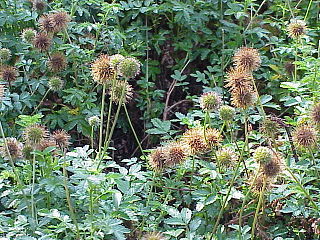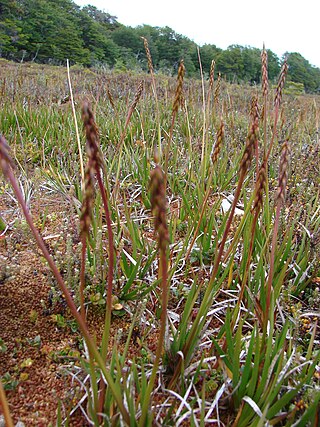Related Research Articles

The Strait of Magellan, also called the Straits of Magellan, is a navigable sea route in southern Chile separating mainland South America to the north and Tierra del Fuego to the south. The strait is considered the most important natural passage between the Atlantic and Pacific oceans. It was discovered and first traversed by the Spanish expedition of Ferdinand Magellan in 1520, after whom it is named. Prior to this, the strait had been navigated by canoe-faring indigenous peoples including the Kawésqar.

The Magellanic subpolar forests are a terrestrial ecoregion of southernmost South America, covering parts of southern Chile and Argentina, and are part of the Neotropical realm. It is a temperate broadleaf and mixed forests ecoregion, and contains the world's southernmost forests.

Acaena is a genus of about 60 species of mainly evergreen, creeping herbaceous perennial plants and subshrubs in the family Rosaceae, native mainly to the Southern Hemisphere, notably New Zealand, Australia and South America, but with a few species extending into the Northern Hemisphere, north to Hawaii and California.

Triglochin is a plant genus in the family Juncaginaceae described by Carl Linnaeus in 1753. It is very nearly cosmopolitan in distribution, with species on every continent except Antarctica. North America has four accepted species, two of which can also be found in Europe: Triglochin palustris and Triglochin maritima. Australia has many more.

Abrotanella is a genus in the family Asteraceae, of 23 species, native to Australia, New Zealand and southern South America.

Navarino Island is a Chilean island located between Isla Grande de Tierra del Fuego, to the north, and Cape Horn, to the south. The island forms part of the Commune of Cabo de Hornos, the southernmost commune in Chile and in the world, belonging to Antártica Chilena Province in the XII Region of Magallanes and Chilean Antarctica. Its population is concentrated primarily in the communal capital, Puerto Williams, and in small settlements like Puerto Navarino, Río Guanaco and Puerto Toro. The highest point of the island is Pico Navarino at 1,195 m (3,921 ft). The island is a popular destination for fly-fishers.

This is a list of taxa comprising the flora of the Antipodes Islands. It includes some species known as megaherbs.

Nothofagus betuloides, Magellan's beech or guindo, is a tree native to southern Patagonia.
Rostkovia is a genus of plant in family Juncaceae described as a genus in 1809.

The Boundary Treaty of 1881 between Argentina and Chile was signed on 23 July 1881 in Buenos Aires by Bernardo de Irigoyen, on the part of Argentina, and Francisco de Borja Echeverría, on the part of Chile, with the aim of establishing a precise and exact border between the two countries based on the uti possidetis juris principle. Despite dividing largely unexplored lands, the treaty laid the groundwork for nearly all of Chile's and Argentina's 5600 km current border.

Astelia is a genus of flowering plants in the recently named family Asteliaceae. They are rhizomatous tufted perennials native to various islands in the Pacific, Indian, and South Atlantic Oceans, as well as to Australia and to the southernmost tip of South America. A significant number of the known species are endemic to New Zealand. The species generally grow in forests, swamps and amongst low alpine vegetation; occasionally they are epiphytic.

Tetroncium is a genus of plants in the Juncaginaceae described as a genus in 1808. It contains only one known species, Tetroncium magellanicum, known from a few sub-Antarctic islands: Tierra Del Fuego, Falkland Islands, and Gough Island. The plant got the name magellanicum because the original description was describing the sample found near the Strait of Magellan.

Gunnera magellanica is a perennial rhizomatous dioeceous herb native to Chile, Argentina and the Falkland Islands, and Andean areas of Peru, Ecuador. In the southern part of its range it grows in damper parts of the Magellanic Forests, and shrub formations on Tierra del Fuego, with an altitudinal range from sea level to 1500m.

The Flora Antarctica, or formally and correctly The Botany of the Antarctic Voyage of H.M. Discovery Ships Erebus and Terror in the years 1839–1843, under the Command of Captain Sir James Clark Ross, is a description of the many plants discovered on the Ross expedition, which visited islands off the coast of the Antarctic continent, with a summary of the expedition itself, written by the British botanist Joseph Dalton Hooker and published in parts between 1844 and 1859 by Reeve Brothers in London. Hooker sailed on HMS Erebus as assistant surgeon.
Ranunculus peduncularis is a large perennial buttercup that grows in Patagonia on the margins of woods, scrubs and along streams, with long stems and deeply divided leaves. In the wild it flowers from spring to summer.
Caltha appendiculata is a perennial herb plant found in several countries of South America.

Caltha dioneaefolia is a dwarf perennial herb, of the Buttercup Family (Ranunculaceae) with apparently seated pale yellow flowers with about seven stamens and two to three free carpels and leaves that are reminiscent of those of the Venus flytrap, but very small and with leaflike appendages on the leaf. C. dioneaefolia occurs in the southern Andes of Chili and Argentina, including on Tierra del Fuego and Hermite Island.

The Botany of Lord Auckland's Group and Campbell's Island is a description of the plants discovered in those islands during the Ross expedition written by Joseph Dalton Hooker and published by Reeve Brothers in London between 1844 and 1845. Hooker sailed on HMS Erebus as assistant surgeon. It was the first in a series of four Floras in the Flora Antarctica, the others being the Botany of Fuegia, the Falklands, Kerguelen's Land, Etc. (1845–1847), the Flora Novae-Zelandiae (1851–1853), and the Flora Tasmaniae (1853–1859). They were "splendidly" illustrated by Walter Hood Fitch.

The Patagonian grasslands (NT0804) is an ecoregion in the south of Argentina. The grasslands are home to diverse fauna, including several rare or endemic species of birds. There are few protected areas. The grasslands are threatened by overgrazing by sheep, which supply high-quality merino wool. Efforts are being made to develop sustainable grazing practices to avoid desertification.
References
- ↑ Joseph Dalton Hooker (1844). Flora Antarctica, Volume 1, Parts 1-2, Flora Novae-Zelandiae - The Botany of the Antarctic Voyage of H.M. Discovery Ships Erebus and Terror in the years 1839-1843. London: Reeve Brothers. pp. title pages.
- ↑ "The Erebus voyage". Kew Royal Botanic Gardens. Archived from the original on 2015-11-23. Retrieved 2015-11-28.
- ↑ Curtis, Winifred M. (1972). Hooker, Sir Joseph Dalton (1817-1911). Australian Dictionary of Biography (Volume 4). Melbourne University Press.
- ↑ David Goyder; Pat Griggs; Mark Nesbitt; Lynn Parker; Kiri Ross-Jones (2012). "Sir Joseph Hooker's Collections at the Royal Botanic Gardens, Kew" (PDF). Curtis's Botanical Magazine. 29 (1): 66–85. Archived from the original (PDF) on 2015-06-08. Retrieved 2016-02-29.
- 1 2 3 Joseph Dalton Hooker (1844). Flora Antarctica, Volume 1, Parts 1-2, Flora Novae-Zelandiae. pp. v–vii.
- ↑ Joseph Dalton Hooker (1844). Flora Antarctica, Volume 1, Parts 1-2, Flora Novae-Zelandiae. pp. 209–223.
- ↑ Joseph Dalton Hooker (1844). Flora Antarctica, Volume 1, Parts 1-2, Flora Novae-Zelandiae. pp. 223–251.